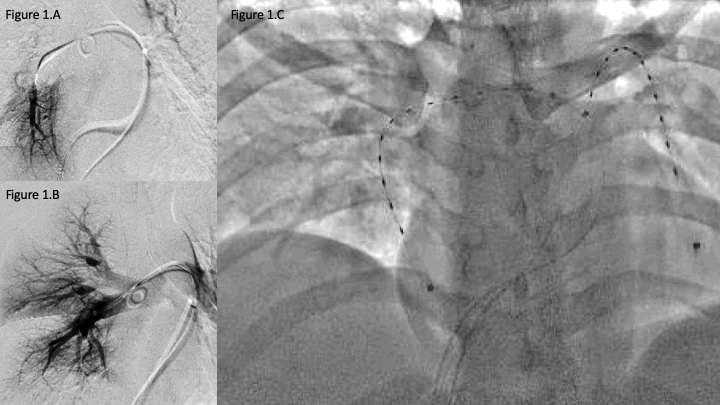Combined ECMO And Catheter Directed Thrombolysis With Percutaneous Pulmonary Artery Thrombectomy For Patient With Massive Pulmonary Embolism
Christopher M. Dominguez, MD, Jaideep Das Gupta, MD, Sundeep S. Guliani, MD.
University of New Mexico, Albuquerque, NM, USA.
Demographics:
A 44-year-old Hispanic woman presented to the emergency department reporting a 2-days history of fatigue and acute shortness of breath. Her past medical history was significant for cerebral arterial-venous malformation and oral contraceptive use. She was noted initially to have a systolic blood pressure less than 80 mmHg and required a non-rebreather mask for profound hypoxia.
History:
A CT chest angiogram revealed a large clot burden pulmonary emboli. She was also noted to have significant right heart dysfunction with a right ventricle to left ventricle ratio of 2.0. She was initially placed on veno-arterial extracorporeal membrane oxygenation (VA ECMO) for cardiopulmonary support. Her hypotension and hypoxia improved with over the next 2 days however she was unable to be weaned off of ECMO support. An echocardiogram at this time showed persistent severe right heart strain and she was then evaluated for a percutaneous pulmonary artery intervention.
Plan:
Adjacent to the left femoral arterial ECMO cannulation site, a left femoral venous access site was chosen, and a 9-French and 6-French sheath was placed. A percutaneous right pulmonary artery thrombectomy was performed using the Penumbra device into the right lower lobar and right upper lobe branches (Figure 1.A). Repeat angiography showed improvement in flow, however a significant clot burden remained (Figure 1.B). We elected then to place 2 EKOS catheters, 1 in the left main pulmonary artery and 1 in the right main pulmonary artery (Figure 1.C). Catheter directed thrombolysis was begun at a rate of 0.5mg/h each catheter for 24 hours. During the thrombolysis period the patient clinically improved and liberated from ECMO support the next day. Her subsequent TTE showed improvement in RV size and function. The remainder of her hospital course was uneventful, and she was discharged on Apixiban 5 days after decannulation. 
Discussion:
Combined ECMO and catheter directed thrombolysis for massive pulmonary emboli is a growing multidisciplinary approach. This case report exemplifies further adjunctive venous therapies, such as percutaneous mechanical thrombectomy at time of EKOS catheter placement. Such therapies can often be implicated in successful management of these critically ill patients.
Back to 2020 Abstracts
